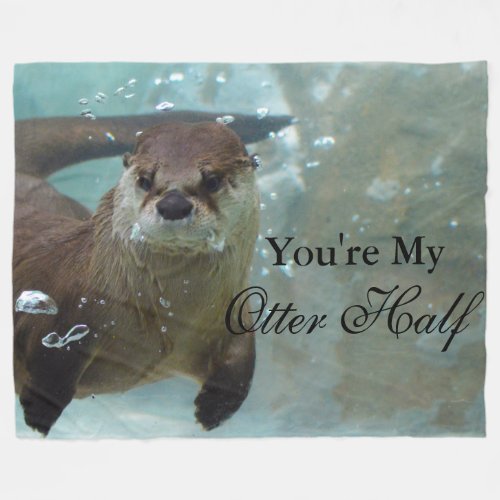Your my Otter Half Brown River Otter Swimming Fleece Blanket



A cute Brown otter swimming in a clear blue pool. The Words "Your My Otter Half" in front of the Design. Sometimes in a fading heart. Words could be swapped for other "Otter themed" sayings like "you otter marry me" or "you otter be with me". Otters have long, slim bodies and relatively short limbs with webbed paws. Most have sharp claws on their feet and all except the sea otter have long, muscular tails. The 13 species range in adult size from 0.6 to 1.8 m (2.0 to 5.9 ft) in length and 1 to 45 kg (2.2 to 99.2 lb) in weight. They have very soft, insulated underfur, which is protected by an outer layer of long guard hairs. This traps a layer of air which keeps them dry and warm under water. Several otter species live in cold waters and have high metabolic rates to help keep them warm. European otters must eat 15% of their body weight each day, and sea otters 20 to 25%, depending on the temperature. In water as warm as 10 °C (50 °F), an otter needs to catch 100 g (3.5 oz) of fish per hour to survive. Most species hunt for three to five hours each day and nursing mothers up to eight hours each day. For most otters, fish is the staple of their diet. This is often supplemented by frogs, crayfish and crabs. Some otters are expert at opening shellfish, and others will feed on available small mammals or birds. Prey-dependence leaves otters very vulnerable to prey depletion. Otters are active hunters, chasing prey in the water or searching the beds of rivers, lakes or the seas. Most species live beside water, but river otters usually enter it only to hunt or travel, otherwise spending much of their time on land to avoid their fur becoming waterlogged. Sea otters are considerably more aquatic and live in the ocean for most of their lives. Otters are playful animals and appear to engage in various behaviors for sheer enjoyment, such as making waterslides and then sliding on them into the water. They may also find and play with small stones. Different species vary in their social structure, with some being largely solitary, while others live in groups – in a few species these groups may be fairly large.


